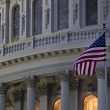by BeiChen Lin, Russell Investments
Key takeaways:
- Tariff uncertainty is continuing
- Canadian small-business confidence fell sharply
- 7.5% earnings growth is anticipated for U.S. Q1 earnings season
On the latest edition of Market Week in Review, Senior Investment Strategist and Head of Canadian Strategy, BeiChen Lin, discussed the latest tariff developments. He also revealed key watchpoints for upcoming U.S. and Canadian employment reports and finished with a preview of U.S. first-quarter earnings season.
Unanswered questions
The week began on an optimistic note after hints that the United States’ reciprocal tariffs—slated to go into effect April 2—might be smaller in scope. This led to a significant rally in the S&P 500 on Monday, Lin said, before a midweek announcement on U.S. auto tariffs caused stocks to drop again.
“Originally, investors were thinking these tariffs might not be implemented until after the reciprocal tariffs take effect. Instead, it looks like the auto tariffs will only lag the reciprocal tariffs by one day,” he remarked.
Lin stressed that the tariff situation remains very dynamic, with the possibility that things could change up to the last minute. There’s also a lot of uncertainty about how these tariffs will be applied, including the countries and products that might be taxed. In addition, other nations might retaliate by slapping their own tariffs on U.S. imports, Lin said.
Because of all these unknowns, it’s unclear how the tariff situation could impact the U.S. economy. “Our central scenario is that the U.S. should be able to avoid a recession—but we do think recession risks are still somewhat above average,” Lin stated.
Unemployment watch
Turning to the labor market, Lin said both Canada and the U.S. will publish employment reports for March next week. In Canada, the unemployment rate will be a big focus due to the country’s weaker jobs market relative to the U.S., he said.
Confidence among small businesses in Canada has plummeted in recent weeks amid anxiety over U.S. tariffs, Lin noted. This is because Canada will probably be more negatively impacted than the U.S. if the tariffs remain in place for a while, he explained.
“I’ll be looking closely at the March report to see how much business anxiety weighed on job creation and the unemployment rate. If the unemployment rate comes in higher, this could bolster the case for the Bank of Canada to cut rates again next month,” Lin commented.
In the U.S., the unemployment rate and the sectors where jobs are being created and lost will both be of interest, he said. The government sector in particular will be a key watchpoint due to the recent layoffs, Lin noted.
“So far, government layoffs haven’t had a significant impact on overall job creation numbers. This next report will show if the U.S. labor market remains resilient,” he remarked.
Earnings expectations
Lin wrapped up with a peek at the upcoming first-quarter earnings season, which kicks off in mid-April. The industry consensus is for 7.5% growth on a year-over-year basis, which he said is a bit of a step down compared to the fourth quarter of 2024. However, Lin stressed that companies sometimes beat initial earnings expectations.
“This has happened a lot in recent seasons, so it’s worth watching. I’ll also be looking at what consumer-facing companies are saying about their plans to potentially adjust pricing due to recent tariff announcements,” Lin said. He concluded by emphasizing that how much companies absorb price increases through their profit margins versus how much they pass along the increase to consumers will be a key focus.
Copyright © Russell Investments















